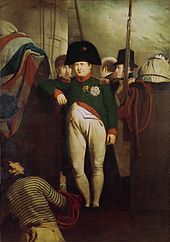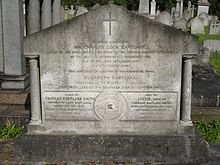- Charles Lock Eastlake
-
For the architect and furniture designer, see Charles Eastlake.
Sir Charles Lock Eastlake RA (17 November 1793 – 24 December 1865) was an English painter, gallery director, collector and writer of the early 19th century.
Contents
Early life
Born in Plymouth, Devon, southwest England, the fourth son of an Admiralty lawyer, Eastlake was educated at local grammar schools in Plymouth and, briefly, at Charterhouse, Surrey.
Career
Set on becoming a painter, in 1809 he became the first pupil of Benjamin Haydon and a student at the Royal Academy schools in London — where he later exhibited.
However his first exhibited work was shown at the British Institution in 1815, a year in which he also visited Paris and studied works in the Louvre (then known as the Musée Napoléon). His first notable success was a painting Napoleon on Board the Bellerophon in Plymouth Sound (1815; now in the National Maritime Museum, London). Like many other people at the time, Eastlake had hired a boat to take him to the ship on which Napoleon was held captive in Plymouth harbour. He sketched him from the boat.
In 1816, he travelled to Rome where he painted members of the British elite staying in Italy including fellow artists Sir Thomas Lawrence and J. M. W. Turner. He also travelled to Naples and Athens.
Despite being based predominantly in mainland Europe, Eastlake regularly sent works back to London for exhibition and in 1827 he was elected a member of the Royal Academy. Three years later, he returned to England permanently where he continued to paint historic and biblical paintings set in Mediterranean landscapes.
As an art scholar, he translated Goethe's Zur Farbenlehre (Theory of Colours, 1840) and the Handbuch der Geschichte der Malerei (Handbook of the History of Painting) by Franz Kugler. These publications and his reputation as an artist led to his nomination in 1841 to become secretary of the Fine Arts Commission, the body in charge of government art patronage. In his On Vision and Colors, § 14, Schopenhauer praised Eastlake's translation of Goethe. "Eastlake, the painter and gallery inspector, furnished his countrymen, in 1840, with such an excellent translation of Goethe's theory of color that it is a perfect reproduction of the original and reads more easily; in fact, it is understood more easily than the original."
Having already advised the National Gallery, London on acquisitions, he was appointed the Gallery's first Keeper in 1843, a post he later resigned to resume writing and painting.
In 1849 he married Elizabeth Rigby, an art historian and translator of German art histories, forming a formidable art history writing partnership.
Elected President of the Royal Academy and knighted in 1850, he became a notable figure in the British art establishment, being appointed the first President of the Photographic Society in 1853 and, in 1855, the first Director of the National Gallery. His directorship was marred by the signal failure of the National Gallery to fulfil the terms of the bequest of J.M.W.Turner, his erstwhile friend. Cambridge University awarded him an honorary degree in 1864.[1]
Legacy
Eastlake died in Pisa, Italy, on Christmas Eve, 1865, and is buried at Kensal Green Cemetery, London. His will provided for the Gallery to purchase his own collection of paintings. Lady Eastlake also sold her husband's art history book collection to the Gallery's library.
See also
Publications
- Materials for a History of Oil Painting (1847).
- Contributions to the Literature of the Fine Arts (1848).
References
- ^ Eastlake, Charles Lock in Venn, J. & J. A., Alumni Cantabrigienses, Cambridge University Press, 10 vols, 1922–1958.
External links
- Archival material relating to Charles Lock Eastlake listed at the UK National Register of Archives
 "Eastlake, Charles Lock". Dictionary of National Biography. London: Smith, Elder & Co. 1885–1900.
"Eastlake, Charles Lock". Dictionary of National Biography. London: Smith, Elder & Co. 1885–1900.
 Chisholm, Hugh, ed (1911). "Eastlake, Sir Charles Lock". Encyclopædia Britannica (11th ed.). Cambridge University Press.
Chisholm, Hugh, ed (1911). "Eastlake, Sir Charles Lock". Encyclopædia Britannica (11th ed.). Cambridge University Press.Cultural offices Preceded by
Sir Martin Archer SheePresident of the Royal Academy
1850–1865Succeeded by
Sir Francis GrantCharles Lock Eastlake (1855) · William Boxall (1866) · Frederick William Burton (1874) · Edward Poynter (1894) · Charles Holroyd (1906) · Charles Holmes (1916) · Augustus Daniel (1929) · Kenneth Clark (1934) · Philip Hendy (1946) · Martin Davies (1968) · Michael Levey (1973) · Neil MacGregor (1987) · Charles Saumarez Smith (2002) · Nicholas Penny (2008)
Categories:- 1793 births
- 1865 deaths
- People from Plymouth
- Old Carthusians
- English curators
- English painters
- English art historians
- Directors of the National Gallery, London
- English translators
- Royal Academicians
- Knights Bachelor
- Fellows of the Royal Society
- Burials at Kensal Green Cemetery
Wikimedia Foundation. 2010.



